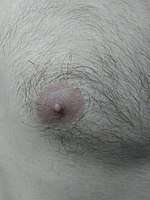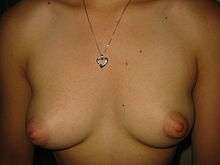Areola
The human areola (areola mammae, /əˈriːələ/[1][2] or /æriˈoʊlə/[2][3]) is the pigmented area on the breast around the nipple. Areola, more generally, is a small circular area on the body with a different histology from the surrounding tissue, or other small circular areas such as an inflamed region of skin.
| Areola | |
|---|---|
 | |
 Breast schematic diagram (adult female human cross section) Legend: 1. Chest wall 2. Pectoralis muscles 3. Lobules 4. Nipple 5. Areola 6. Duct 7. Fatty tissue 8. Skin | |
| Details | |
| Identifiers | |
| Latin | areola mammae |
| TA | A16.0.02.012 |
| FMA | 67796 |
| Anatomical terminology | |

The mature human female nipple has several small openings arranged radially around the tip of the nipple (lactiferous ducts) from which milk is released during lactation. Other small openings in the areola are sebaceous glands, known as Montgomery's glands.[4]
Color

The areolae can range from pink to red to chocolate brown to dark brown or nearly black, but generally tend to be paler among people with lighter skin tones and darker among people with darker skin tones. A reason for the differing color may be to make the nipple area more visible to the infant.[5]
Size and shape

The size and shape of areolae and nipples are also highly variable, with those of women usually being larger than those of men and prepubescent girls. Human areolae are mostly circular in shape, but many women have large areolae that are noticeably elliptical.
The average diameter of male areolae is around 28.0 mm (1.1 in). Sexually mature women have an average of 38.1 mm (1.5 in), but sizes can exceed 100 mm (4 in).[6] Lactating women, and women with particularly large breasts, may have even larger areolae. A function of the specialized dermis of the areola is to protect the regular breast skin from wear, cracking, and irritation. Infants sometimes create trauma to the nipple and areolae by latching-on of the infant.[7] Another function of an areola is to house slowly-adapting mechanoreceptors that trigger oxytocin excretion during nursing. The size of the areola implies a need to protect a larger area than the nipple due to many factors that are not fully known.
Rated according to the Tanner scale of physical development, in stage four, the areolae are raised.[8] In stage five, they are no longer raised.[8]
Mechanoreceptors
Breastfeeding by the baby innervates slowly adapting and rapidly adapting mechanoreceptors that are densely packed around the areolar region.
Diseases
Paget's disease of the breast is a malignant condition that outwardly may have the appearance of eczema, with skin changes involving the areola and nipple.
References
| Wikimedia Commons has media related to Areola. |
| Look up areola in Wiktionary, the free dictionary. |
- OED 2nd edition, 1989.
- Entry "areola" in Merriam-Webster Online Dictionary.
- The plural of areola is areolas or areolae, which is pronounced /əˈriːəliː/ or /əˈriːəlaɪ/. "Areola" is the diminutive of Latin area, "open place".
- "PLOS ONE". plosone.org. Retrieved 9 January 2016.
- "Dark nipples: 7 causes and when to see a doctor". Medical News Today. Retrieved 2019-02-10.
- Hussain, M.; Rynn, L.; Riordan, C.; Regan, P. J. (2003). "Nipple-areola reconstruction: outcome assessment". European Journal of Plastic Surgery. 26 (7): 356–358. doi:10.1007/s00238-003-0566-x.
- Santos, Kamila Juliana da Silva; Santana, Géssica Silva; Vieira, Tatiana de Oliveira; Santos, Carlos Antônio de Souza Teles; Giugliani, Elsa Regina Justo; Vieira, Graciete Oliveira (2016). "Prevalence and factors associated with cracked nipples in the first month postpartum". BMC Pregnancy and Childbirth. 16 (1). doi:10.1186/s12884-016-0999-4. ISSN 1471-2393. PMC 4975913.
- Le, Tao; Bhushan, Vikas; Tolles, Juliana (2011). First Aid for the USMLE Step 1 2011. McGraw-Hill Medical.